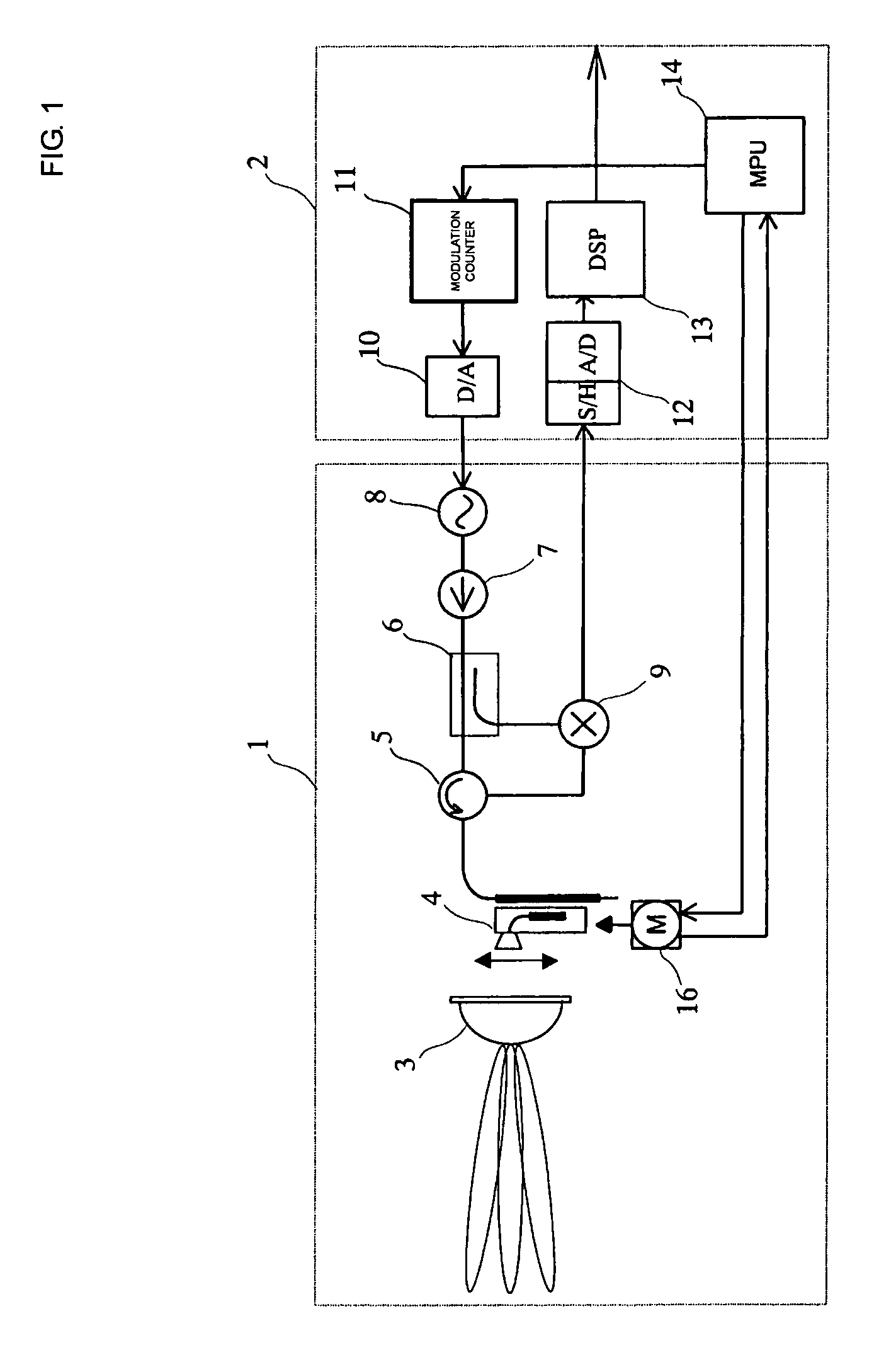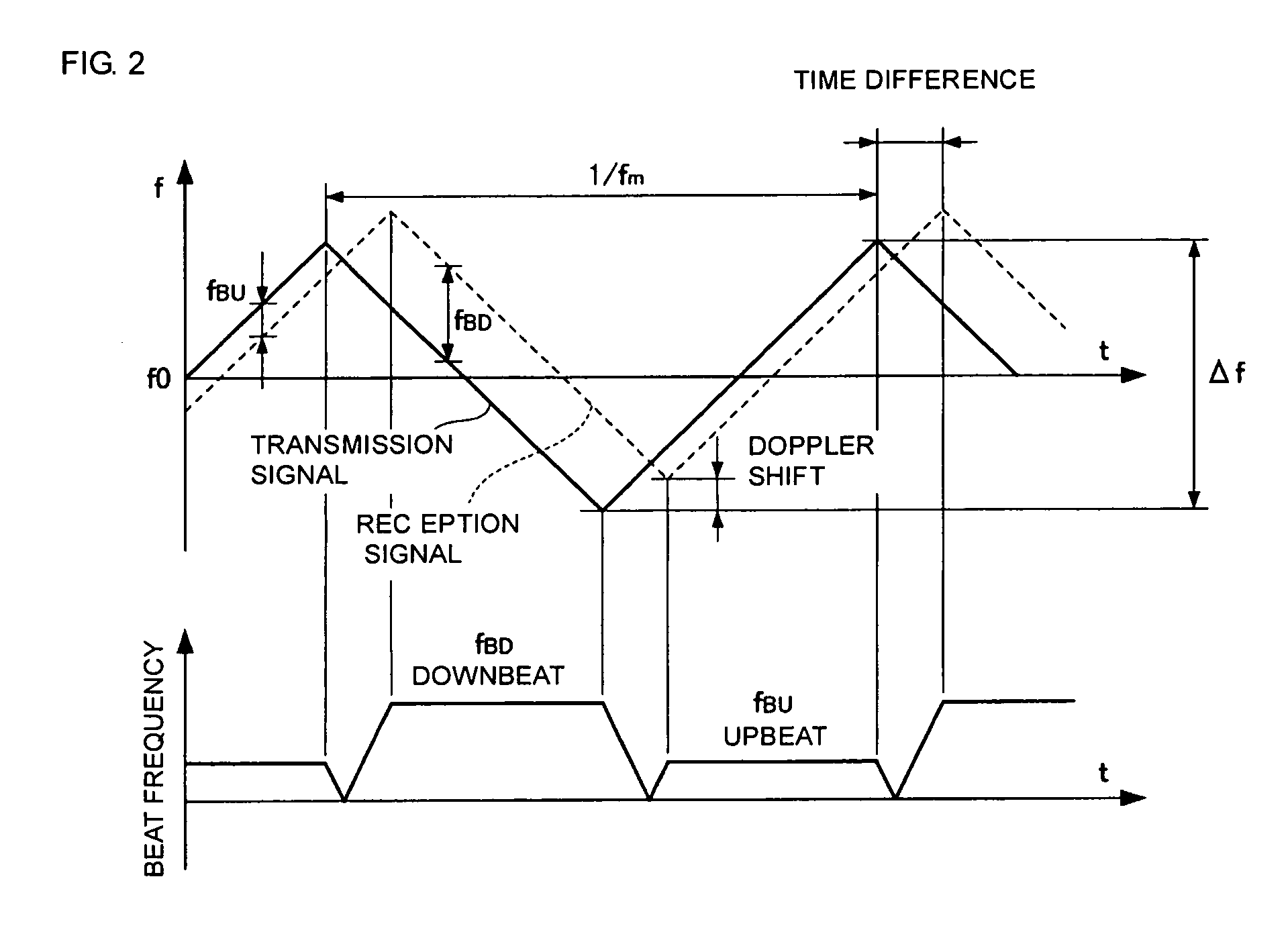Radar system
a radar system and target detection technology, applied in the field of radar systems, can solve the problems of difficult detection of targets, distortion of modulation waveforms, oscillation characteristics of vcos, etc., and achieve the effects of easy and reliable and accurate detection of targets over a wider rang
- Summary
- Abstract
- Description
- Claims
- Application Information
AI Technical Summary
Benefits of technology
Problems solved by technology
Method used
Image
Examples
first embodiment
[0052]FIG. 3 is a block diagram showing a signal processing system in the DSP 13 shown in FIG. 1. beat signals are sampled, a first window function is applied to the sampled data sequence, and discrete Fourier transform is performed in a first frequency analysis. Similarly, a second window function is applied to the sampled data sequence and the discrete Fourier transform is performed in a second frequency analysis. Finally, a spectrum peak is extracted from the first and second frequency spectra.
[0053] The window function is applied to the sampled signals when the discrete frequency spectrum of the beat signal is to be yielded by the FFT or the like to suppress an influence of the discontinuity of the signal.
[0054]FIG. 4 includes graphs showing examples of the signal processing to which the window function is applied and the frequency spectra resulting from the signal processing. FIG. 4(A) shows the time waveform of a beat signal. A predetermined window function shown in FIG. 4(B...
second embodiment
[0072] The structure of a radar system will now be described with reference to FIG. 12.
[0073] According to the first embodiment, as shown in FIG. 3, beat signals are sampled during the sampling period to yield a predetermined number of pieces of data and the first and second frequency analyses are performed to the sampled data. In contrast, in the example shown in FIG. 12, the sampled data is decimated and the first frequency analysis is performed to the decimated data. Specifically, the first frequency analysis uses the pieces of sampled data of a number that is smaller than that of the pieces of sampled data used in the second frequency analysis.
[0074] As shown in FIGS. 10(A) and 10(B), since the frequency spectrum yielded when the first window function is applied uses a near range (lower frequency range), it is enough to sample a smaller number of pieces of sampled data. Accordingly, performing the frequency analysis to the decimated data allows the required processing power to...
third embodiment
[0075] A radar system will now be described with reference to FIG. 13.
[0076] Although the first and second frequency analyses are simultaneously performed in the first and second embodiments, the first and second frequency analyses may be performed in a time-shared manner. For example, as shown in FIG. 13, the application of the first window function to the data about the sampled beat signals to perform the discrete Fourier transform may be performed at a timing different from a timing when the second window function is applied to the data about the sampled beat signals to perform the discrete Fourier transform. In addition, the first or second window functions may be selectively applied depending on a required frequency band as long as the first window function is applied to a lower frequency range (near range) in the frequency spectrum and the second window function is applied to a higher frequency range (far range) therein.
[0077] In other words, the current location of each tar...
PUM
 Login to View More
Login to View More Abstract
Description
Claims
Application Information
 Login to View More
Login to View More - R&D
- Intellectual Property
- Life Sciences
- Materials
- Tech Scout
- Unparalleled Data Quality
- Higher Quality Content
- 60% Fewer Hallucinations
Browse by: Latest US Patents, China's latest patents, Technical Efficacy Thesaurus, Application Domain, Technology Topic, Popular Technical Reports.
© 2025 PatSnap. All rights reserved.Legal|Privacy policy|Modern Slavery Act Transparency Statement|Sitemap|About US| Contact US: help@patsnap.com



